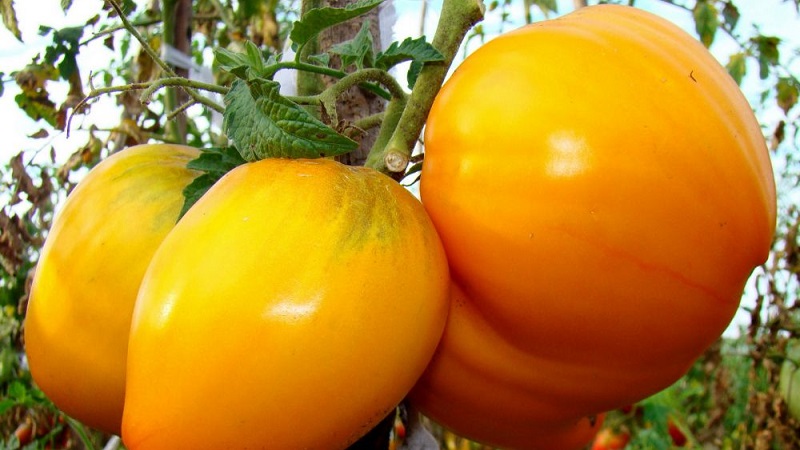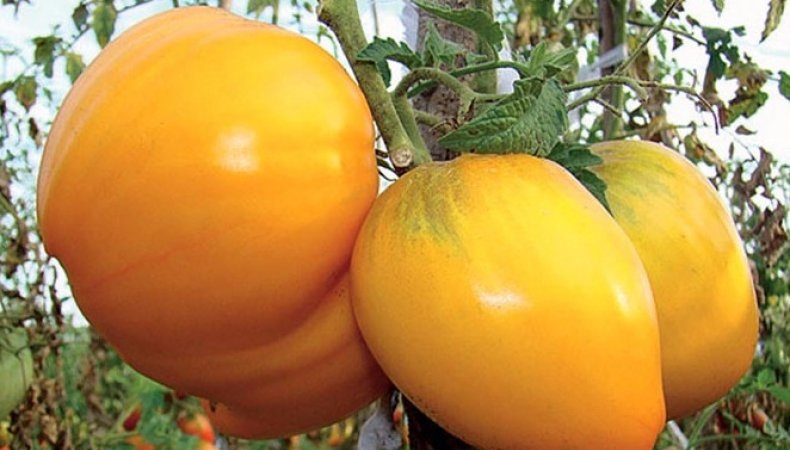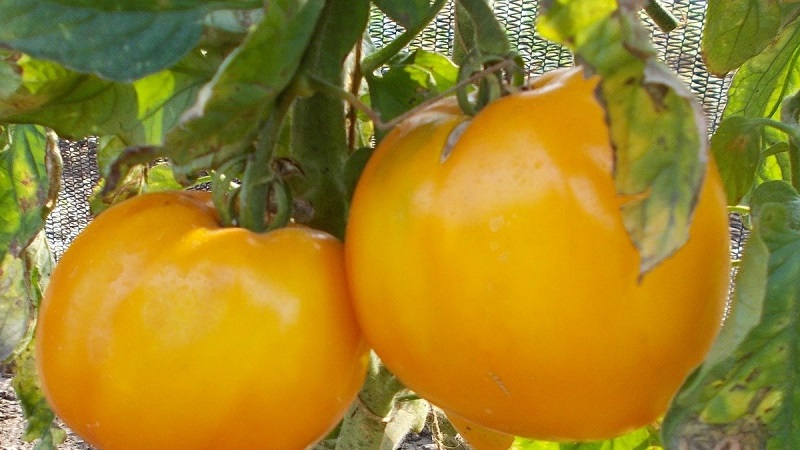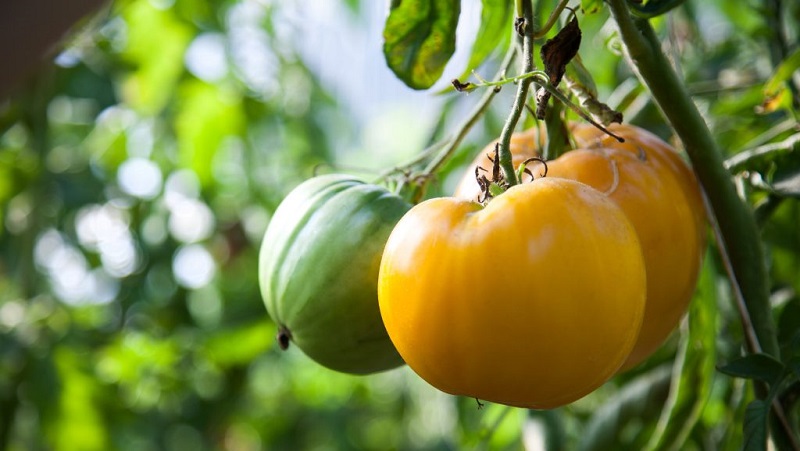The newest promising variety that you will like - the tomato "King of Siberia": photos and distinctive features
In the harsh climate of Siberia, with long winters and short summers, growing a decent harvest is not easy. Therefore, breeders are trying to breed varieties that are resistant to different weather conditions. One of them is the King of Siberia. Its main task is to withstand any bad weather and give a rich harvest.
Ripe yellow tomatoes are distinguished not only by their large size, but also by a high content of beta-carotene, dietary fiber and vitamin B. They are a real storehouse of nutrients that each of us needs for good health.
The content of the article
Characteristics and description of the variety
Tomato King of Siberia was bred relatively recently. It is not included in the State Register, as it is at the stage of experimental research. The copyright holder of the variety is the agrofirm "Aelita". Now it is one of the leaders in the field of selection and breeding of the latest crops.
Distinctive features
A type indeterminate, that is, unlimited in height, 2 meters or more high. The stem is strong, there are 5 brushes on the stem, each tying 3-5 fruits. The foliage is weak, the leaves are small, dark green. The root system is powerful.
The ripening period is average, from the moment of sowing the seeds to full ripening 110-120 days pass.
The yield is high, 3-3.5 kg of fruits are harvested from 1 seedling, provided that 3 plants are planted per 1 sq. m.
Tomato's genes have resistance to fungal and bacterial diseases, the culture is immune to phytophthora, tobacco mosaic, alternaria. Recommended for open field and greenhouse breeding.
Tomatoes need regular pinching due to the large number of shoots and the obligatory garter of tall bushes. Otherwise, the fruitful branches will not withstand the weight of ripe vegetables.

Fruit characteristics
Fruits are large, weight reaches 400-800 g. Heart-shaped, bright orange color. The taste is sweet due to the high glucose content, the pulp is juicy, there are few seeds.
The purpose of tomatoes is universal: they are consumed fresh and used for winter preparations. Smaller tomatoes are canned whole, they look especially beautiful together with red tomatoes.
Reference. Yellow vegetables are rich in beta-carotene and do not belong to allergens, unlike red ones. Therefore, they are suitable for baby and diet food.
The culture is bred in summer cottages and farms, using it for commercial purposes.
The photo shows the King of Siberia tomatoes.

How to grow seedlings
Planting seedlings begins at the end of March. The culture is not hybrid, which means that it is possible to select seeds for planting from the fruits. Seed material collected independently undergoes mandatory preparation before sowing.
Seed preparation
Seeds are determined to void by immersion in saline solution for 10 minutes. Those seeds that float to the surface are not suitable for planting. The remaining grains are disinfected in a weak solution of potassium permanganate for 30 minutes. After that, they are washed with running water.
Reference. The manganese solution can be replaced with 2% hydrogen peroxide.
To increase the germination percentage, seed soaked in a growth stimulator for 10-12 hours.Specialized preparations can be replaced with potato juice, aloe juice, or ordinary boiled water.
Capacity and soil
The soil is prepared from compost, river sand and garden soil in equal proportions. All components are thoroughly mixed and spilled with a hot solution of potassium permanganate to destroy pathogenic flora. The cooled soil is laid out in planting containers, at the bottom of which small drainage holes are made in advance, where excess moisture will drain.
You can plant in a common wooden box or in individual containers: plastic and peat cups or paper honeycombs.
Reference. When sowing seeds in plastic cups, drainage holes at the bottom are required. Otherwise, when moisture stagnates, there is a high probability of a black leg.
Sowing
Seed material is sown to a depth of 2 cm with a distance of 1.5-2 cm from each other. Sprinkle on top with peat, compact and watered with warm, settled water using a spray bottle. Then they are covered with a film to create a greenhouse effect and left in a bright and warm room at a temperature of at least 22 ° C. The film is periodically removed for ventilation.
Seedling care
When seedlings appear, the containers are rearranged on the windowsill to obtain the required amount of light. Daylight hours for seedlings should be at least 13 hours. If there is a lack of natural light, they are supplemented with fluorescent phytolamps.
Reference. In case of insufficient light, the seedlings stretch up and weaken.
Watered in moderation, without flooding the sprouts, with warm, settled water using a shallow watering can. After watering, the soil is loosened superficially, thereby ensuring the saturation of the soil with oxygen.
When 4 true leaves are formed, the seedlings dive, seating them in separate containers. A picking involves shortening the main spine by one third. After this procedure, the seedlings develop more intensively.
Attention. When using peat cups, picking is not required.
2 weeks before planting in the ground, the seedlings begin to harden, taking the planting containers outside in the daytime for 1 hour. The hardening procedure allows young plants to quickly get used to new conditions after transplanting into the ground. Every day the time spent on the street is increased to 12 hours.

How to grow tomatoes
By June, the seedlings are ready for transplanting into the ground. In greenhouse conditions, seedlings are planted 2 weeks earlier.
Landing
The soil is prepared 2 weeks before transplanting, digging up and adding humus. They are transplanted into holes 15-20 cm deep, on the bottom of which a little sawdust or wood ash is previously placed.
Planting pattern: 50 cm - the distance between the seedlings, 60 cm is left between the rows. For 1 sq. m 3 plants are placed in a checkerboard pattern. With this method, each bush receives a sufficient amount of light and is well ventilated.
After transplanting, the earth is compacted, watered with warm, settled water and the young bushes are left to get used to the new conditions for several days.
Further care
Regular watering is set no more than 2 times a week, watered with warm, settled water under the root, the tomato does not like irrigation of leaves. Before fruiting, watered abundantly, at least 5 liters of water per 1 seedling. At the time of the formation of the ovaries, watering is reduced, since the fruits can crack from excess moisture.
After watering, the soil is loosened, removing weeds with roots. Loosening oxygenates the root system. To retain moisture in the beds, they are mulched with straw or peat. This is especially important on dry days.
The culture is fed three times per season: during flowering, at the time of the formation of ovaries and during the fruiting period. A full range of minerals or organics are used as fertilizers. Mineral fertilizing with nitrogen content is given 2-3 weeks after transplantation. Nitrogen helps plants grow green mass.
Fertilizers with a predominant content of phosphorus and potassium are given during the period of ovary formation and fruiting. Such dressings accelerate fruit ripening.
From organics, an infusion of mullein or bird droppings is used in a ratio of 1:15. Such a strong dilution is necessary so that the root system does not burn.
Features of cultivation and possible difficulties
Indeterminate type requires a mandatory garters tall seedlings. The sooner the stem is fixed to the support, the more powerful it will form. To do this, a metal or wooden support is installed next to each seedling and the stem is tied to the support almost immediately after transplanting. In addition to the stem, fruiting branches are fixed to the support as they grow.
The most convenient way to tie up is to fix it on a trellis. Plants are fixed to a horizontally stretched wire with soft fabric tapes.
Culture needs regular pinching due to the large number of shoots. Stepchildren who have reached 5 cm are removed in the morning so that the wounds have time to heal by evening. To prevent infection, the cut sites are sprinkled with ash or treated with a solution of potassium permanganate.
For a maximum fruiting rate, the plant is led in 1 or 2 stems.

Diseases and pests
Varietal traits include high resistance to diseases of the Solanaceae family. It is also immune to the attacks of many pests. However, do not forget about simple preventive measures, which include regular loosening, weeding, mulching and moderate watering. Agrotechnical rules recommend treating the beds with copper sulfate before planting tomatoes, which prevents fungal spores from developing.
In open ground, the Colorado potato beetle and its larvae are dangerous. Regular inspection of seedlings for pests prevents the parasite from multiplying rapidly. Females lay the larvae on the back of the leaves, so a careful examination of the plants from all sides is necessary. If there is a lot of beetles, use the drug "Commander" or "Prestige".
Reference. Plants are treated with chemical agents in sunny weather.
The nuances of cultivation in the open field and in the greenhouse
When a bush is kept in 2 stems, the largest quantitative indicator of fruiting is observed. In this way, the variety is grown mainly in cold regions. In the southern area, the culture is carried out in 1 stem.
With an excess of moisture, not only the root system suffers, but also cracking of the fruit is possible. In addition, the moisture level rises, which leads to the formation of mold. Excess moisture is most dangerous in closed structures, therefore greenhouses are aired on a daily basis without fail.
The lower leaves are removed from all plants, otherwise they will rot from constant contact with wet beds.
The growth of greenhouse plants is slightly higher than in open beds. To restrict growth, the crown of the plants is pinched, preventing the development of new branches. During the period of fruit formation, it is important that the plant consumes nutrients for the formation of ovaries, and not for the growth of unnecessary branches.
In the open field, it is recommended to plant the tomato in a place shaded from the daytime sun. An excess of ultraviolet radiation inhibits the growth of a plant, while a deficiency does not affect it at all.

Harvesting and application of the crop
The collection of "royal" tomatoes begins in August. The first fruits are especially large, they are great for fresh consumption. They are used to make salads, various snacks, hot and vegetable dishes. Ripe vegetables are processed into tomato products and used for the preparation of winter preparations: pickles and pickles. Yellow vegetables look especially beautiful in jars along with red ones.
It is not necessary to wait for the vegetables to fully ripen; they are able to pick up color on their own at room temperature. This quality is especially appreciated in regions with short summers.
Due to the increased glucose content, which gives a sweet taste, vegetables are suitable for baby food. They are also recommended for allergy sufferers and for dietary nutrition.
Advantages and disadvantages
Consider the positive aspects of the King of Siberia:
- high rate of fruiting;
- ovary formation does not depend on weather factors;
- mid-early ripening;
- unpretentious care;
- strong immunity to diseases;
- the possibility of breeding in all regions;
- excellent taste;
- large yellow fruits;
- suitable for dietary meals;
- versatility in cooking;
- the possibility of using it for commercial purposes.
Negative properties include:
- obligatory garter;
- regular pinching;
- cracking of fruits from excess moisture.

Farmers reviews
Judging by the characteristics and reviews, the tomato is well known among gardeners, despite its short existence. However, many gardeners have already tried the variety on their plots. Here are their opinions on tomato:
Natalia, Chelyabinsk: “I planted the seedlings in May, and picked tomatoes in early August. She did not pay special attention to tomatoes: she watered, pinned and tied up. On the first bunches, real giants grew, weighing up to 600 g, the latter are smaller. They went for salting. Together with the red ones, they look very beautiful in a glass jar. "
Elizaveta, Krasnoyarsk: “For the first time I saw the King of Siberia in the photographs, the price suited me, and I decided to drop him off at my place. There is practically no care. During the growing season, the culture did not hurt, there were no pests. I collected 4 kg of vegetables from one plant. Delicious, sweet, no acid, with a pleasant aroma. I advise everyone to plant a variety on their site. "
Conclusion
Tomato King of Siberia is a real gift for vegetable growers in the northern regions. Yellow tomatoes with excellent taste are characterized by unpretentious care, high yield and strong immunity to diseases.
The fact that the variety is already being used commercially is evidence of its reliability and high demand in the markets. It can be assumed that the culture will take a leading position among other Siberian varieties and hybrids.